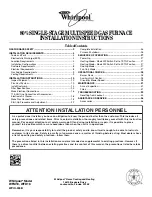
44
If the unobstructed distance from the foundation to the property
line of the adjacent lot is no less than 4 ft. (1.2 M) and no greater
than 8 ft. (2.4 M), it will be necessary to re-direct the flue gas
plume. In this situation, a concentric vent kit cannot be used. A
2-pipe termination (or single pipe termination when permitted with
ventilated combustion air applications) that re-directs the flue gas
away by use of an elbow or tee, certified to ULC S636 from the
adjacent property line must be used. See Fig
.
56.
The concentric vent kit currently cannot be modified to attach an
elbow to the vent portion of the rain cap. A tee attached to the rain
cap could potentially direct the flue gas plume toward the intake
air stream and contaminate the incoming combustion air for the
furnace.
Refer to Fig. 56 for terminations approved for use in Alberta and
Saskatchewan.
Size the Vent and Combustion Air Pipes
General
Furnace combustion air and vent pipe connections are sized for
2-in. (50 mm ND) PVC/ABS DWV pipe. The combustion air and
vent pipe connections also accommodate 60 mm polypropylene
venting systems with outside diameters of approximately 60 mm
(2--3/8 inches). Any pipe diameter change should be made outside
furnace casing in vertical pipe. Any change is diameter to the pipe
must be made as close to the furnace as reasonably possible. See
Fig. 39.
The
for the vent and combustion air pipe (when used) is
determined from the Maximum Equivalent Vent Length in Table
14 minus the number of fittings multiplied by the deduction for
each type of fitting used from Table 15.
OPTIONAL CONFIGURATION FOR COMBUSTION
AIR INLET PIPE
In applications where there is a risk of excessive moisture
entering the combustion air inlet pipe, a moisture trap may be
added to the inlet pipe to help prevent moisture from entering
the furnace from the combustion air inlet pipe. See Fig. 40.
When sizing venting systems, the equivalent length of the
optional moisture trap (15 feet/5 M) must be taken into
account.
NOTICE
FURNACE
PIPE DIAMETER
TRANSITION IN
VERTICAL SECTION
NOT IN
HORIZONTAL
SECTION
A93034
Fig. 39 -- Combustion Air and Vent Pipe Diameter Transition
Location and Elbow Configuration
Recommended Combustion Air Inlet Moisture Trap
To prevent moisture from trickling into the furnace vestibule, a
trap can be installed in the intake air pipe near the furnace. To
prevent moisture, connecting a drain line to the trap is
recommended as trace amounts of moisture will evaporate into the
intake air stream. If the combustion air inlet is located near a
moisture exhaust duct, or there are other concerns of excessive
moisture being drawn into the combustion air inlet, it is
encouraged to connect a drain line to the trap.
The trap can be constructed from a running tee of the same
diameter of the intake air pipe with
EITHER
a removable cap
attached to a 6-inch long pipe connected to the tee or the External
Vent Trap Kit to help prevent contaminants from entering the
furnace. See Fig. 40.
The External Vent Trap Kit accessory may be used as a trap for the
combustion air inlet pipe if a large amount of moisture must be
removed. The drain line may be connected to the same drain as the
furnace condensate and the evaporator coil condensate line
ONLY
if the inlet air trap drain and the evaporator coil drain empty into
an open segment of pipe above the drain. See Fig.17. When
using the External Vent Trap Kit, refer to those instructions for
proper drain connections.
The tee may also be connected to the intake air pipe on the side of
the casing. See Fig. 40.
In any configuration, it will be necessary to add the equivalent
length of the tee (15 feet/5 M) to the Total Equivalent Vent Length
of the venting system.
















































